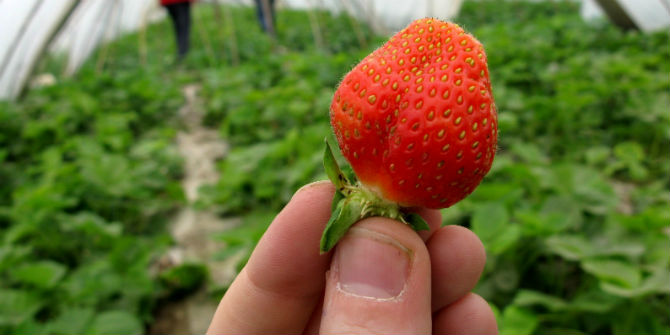 British agriculture relies heavily on seasonal migrant labour, and much of this comes from the EU. Where will farmers turn to find workers after Britain leaves the EU – particularly if, as one cabinet minister has suggested, they come under pressure to grow more food for the domestic market and thereby keep prices down? Wyn Grant (University of Warwick) looks at the choices facing farmers and suggests that reviving the Seasonal Agricultural Workers Scheme might offer a solution.
British agriculture relies heavily on seasonal migrant labour, and much of this comes from the EU. Where will farmers turn to find workers after Britain leaves the EU – particularly if, as one cabinet minister has suggested, they come under pressure to grow more food for the domestic market and thereby keep prices down? Wyn Grant (University of Warwick) looks at the choices facing farmers and suggests that reviving the Seasonal Agricultural Workers Scheme might offer a solution.
Most of the fruit and vegetables sold in the UK are imported. The transport secretary Chris Grayling recently suggested that British farmers might grow more to drive down food prices after Brexit. This is unrealistic. The supply of land is fixed (or even declining slightly because of development) and more intensive farming could damage the soil, already a subject of concern, and lead to other environmental problems. It is impractical to talk of achieving anything approaching self-sufficiency in temperate foodstuffs.
Nonetheless, given the contribution that fruit and vegetables make to a healthy diet, there is a case for growing some of them within the UK – particularly as there may be disruption to imports at the Channel ports after Brexit. However, the mix of products may change. For example, some growers are already moving away from broad beans, which offer relatively low margins – although they are valuable as part of a rotation of crops.

Domestic farmers also need plenty of seasonal migrant labour, and much of this comes from the EU. It is used extensively in the field vegetable, top and soft fruit sectors of the UK agriculture. The National Farmers’ Union monthly labour survey showed a 29 per cent shortfall in seasonal workers for horticulture businesses in September, deepening from a 17 per cent shortfall in May. According to Defra, there were 67,000 seasonal agricultural workers in 2015, although the industry puts the number higher at 80,000 from a total of 476,000 employed in agriculture. Three-quarters of seasonal labour in the horticultural sector comes from Romania and Bulgaria.
Recruitment has been affected by the falling value of the pound, but also by increasing prosperity in some of the sending countries. Some workers have a perception that they are no longer welcome in Britain. Some growers have been offering higher wages, but this has had relatively little effect.
In addition, a survey by the Royal Association of British Dairy Farmers has revealed that one-third of dairy farmers in the UK rely on migrant workers. These workers are not seen as transient or seasonal workers but rather permanent members of the team. Many of the farmers questioned cited a poor work ethic among British workers: migrants, on the other hand, were seen as hardworking. About 57 per cent of migrant workers in dairy farming are from Poland, with a significant number from the Baltic states, especially Latvia. However, migrant workers are also employed from non-EU countries, especially the Philippines and New Zealand.
Migrant workers in farming are seen to have a number of advantages by employers compared to dipping into the local unemployed pool. They are thought to have a lower turnover and absenteeism, be prepared to work longer and flexible hours, be satisfied with their duties and hours and work harder in terms of productivity and speed.
Recruiting and retaining British workers is not easy, particularly at a time of virtually full employment. Much of the work is strenuous, repetitive and often requires 12-hour shifts. The farms are not normally in areas where unemployment is high and British workers are reluctant to live on the farm, as migrant workers do.
Some argue that the reliance on relatively cheap labour has discouraged the development of new technologies for picking. Experiments are being conducted with robotics, but their widespread use is a long way off and would involve considerable expense. Although there is mechanisation in the sector, a considerable amount of labour is required to operate the picking rigs used for vegetables (fruit generally has to be picked by hand). This also applies to the washing and packaging of crops. Machines to pick strawberries and apples are being deployed, but they pick at only one-third of the rate of a human and miss 15 per cent of the crop. Moreover, the machines can cost something approaching £200,000. Most farmers reckon that their large-scale deployment is at least a decade away.
For a long time, the need for migrant labour was met by the Seasonal Agricultural Workers Scheme (SAWS). This was in existence in one form or another for over 60 years. In 2003/4 there were 25,000 places on the scheme. In 2005 this was reduced to 16,250 following the accession of eight East European states to the EU. From 2008, the scheme was only open to workers from Bulgaria and Romania (the A2 countries). The number of places had to be increased by 5,000 after labour shortages in 2007 and 2008 which saw crops left in the ground and produce having to be imported to fill supermarket shelves. The scheme came to an end in 2013 when A2 workers no longer had any restrictions on where they could work in the EU.
Many of those who came under the scheme were students in search of summer work with no intention of settling permanently. They were also interested in improving their English language skills and the better producers organised classes for them.
Could a new version of the SAWS scheme meet the need for seasonal migrant labour? Even Leave voters are not generally opposed to a scheme for seasonal workers, which would be a form of controlled migration. The issue has been batted backwards and forwards between the Home Office and Defra.
The government has now responded to the Commons Defra select committee report on the agricultural labour market. It argues that the sector faces a ‘challenging situation’ rather than a crisis. However, it does not rule out a new version of the SAWS scheme and says that such a scheme could be introduced within months of it being needed.
But the SAWS scheme could not be simply updated for a post-Brexit era, not least because SAWS was designed to operate alongside the EU’s freedom of movement rules and was capped at 21,000 workers, well below the 80,000 the industry now requires.
What will be needed after Brexit is a new version of SAWS, not confined to the EU. Selecting the countries that would be eligible to participate would be politically sensitive, but candidates could include the Ukraine, Morocco and Thailand. The non-EU countries chosen would be a matter for debate, but would be politically stable areas within a reasonable distance of the UK such as the Ukraine.
This post represents the views of the author and not those of the Brexit blog, nor the LSE.
Wyn Grant is Emeritus Professor of Politics at the University of Warwick. He worked closely on research projects with colleagues in the Department of Life Sciences and taught there and at the Warwick Crop Centre, Wellesbourne.






